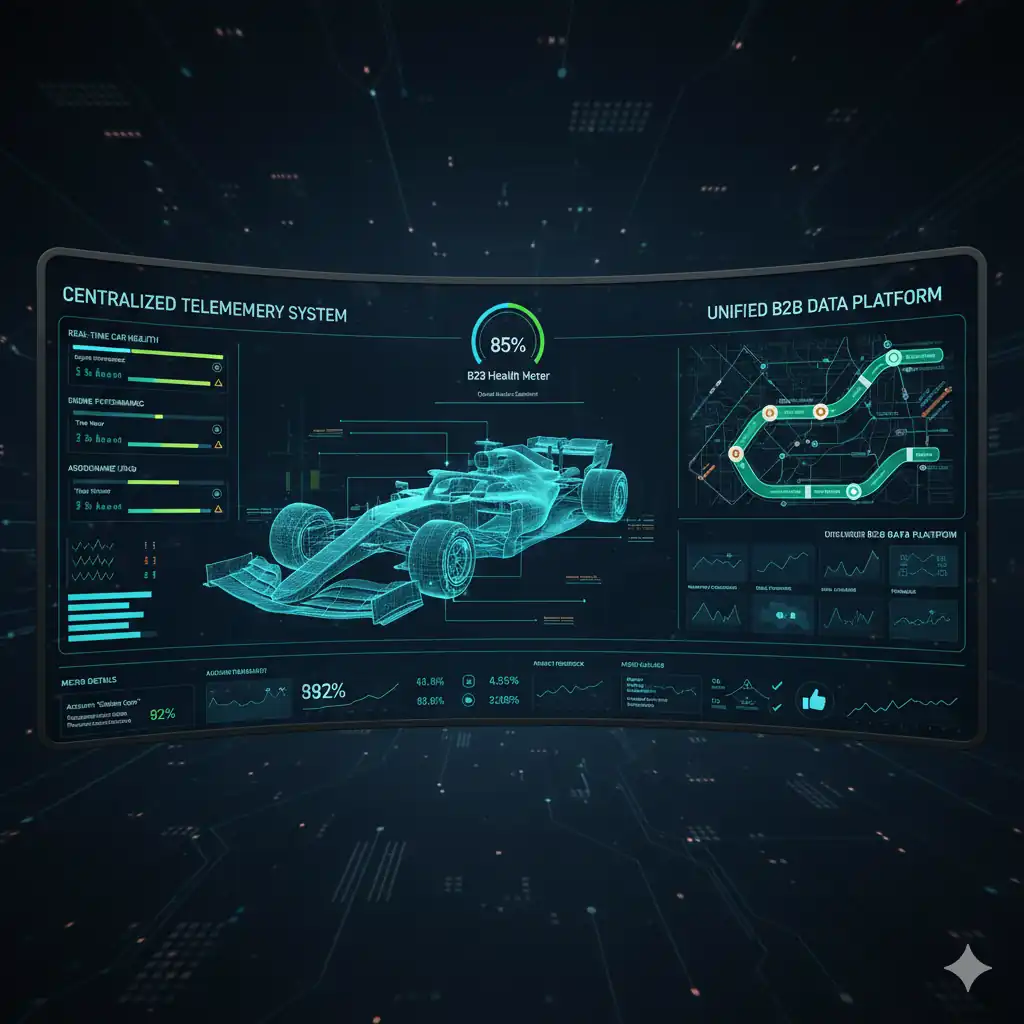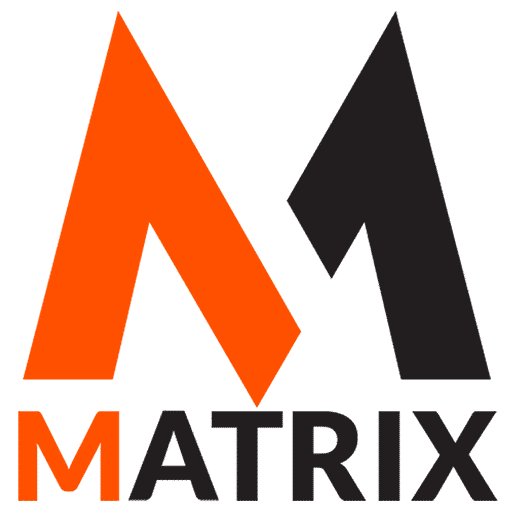The PrescientIQ & Matrix Marketing Group Blueprint: Engineering Intelligent Enterprises for Predictive Growth
Learn How PrescientIQ and Matrix Marketing Group Blueprint: Engineering Intelligent Enterprises for Predictive Growth.
Alright, CMOs, let’s ditch the jargon and dive into an analogy that brings to life how AI simulation, unified data, and cognitive marketing frameworks are fundamentally reshaping B2B growth.
Imagine your B2B enterprise isn’t just a business, but a High-Performance Race Car.
Traditionally, managing your marketing and sales operations was akin to being a racecar driver in the early days of motorsports.

You had a powerful engine (your product/service), a sturdy chassis (your brand), and a team of mechanics (your marketing and sales teams).
Old Way:
- Driving Blind: You’d drive the track (the market) relying on intuition, a few historical laps, and maybe a few glances at the rearview mirror.
- Segmented Data: Each mechanic had their own logbook for tire pressure, fuel consumption, engine diagnostics, and other relevant data. They rarely shared real-time insights or connected the dots across different systems.
- Reactive Adjustments: If you spun out or hit a wall (a lost deal or failed campaign), you’d come into the pit, analyze what went wrong, and make adjustments for the next race.
- Human-Limited Strategy: Your race strategy was based on your experience and the limited data you could manually process.
The “Rewiring” with AI Simulation, Unified Data, and Cognitive Marketing:
Now, let’s fast-forward to the modern era of racing, where your B2B enterprise transforms into a Formula 1 Team with an Advanced Digital Twin.
Here’s how the new components fit in:
Unified Data Platform: The Centralized Telemetry System Imagine every single sensor on your F1 car – from engine temperature and tire wear to aerodynamic drag and driver input – feeding into one massive, real-time telemetry system.
This isn’t just data points; it’s a living, breathing digital representation of your car’s performance.
- What it means for B2B: This is your integrated CRM, marketing automation, sales enablement, customer service, web analytics, and financial data – all consolidated into a single, accessible platform. Every customer interaction, every touchpoint, every piece of market feedback is captured and contextualized in one place. No more siloed data; everyone sees the full picture.
- UI/UX: Think of a sleek, interactive dashboard displaying a real-time “health meter” for your entire customer journey. You can drill down from macro trends (overall market sentiment, pipeline velocity) to micro-details (an individual account’s engagement score, predicted next best action). Colors, alerts, and dynamic graphs quickly highlight opportunities and risks.
1. Executive Summary
Artificial Intelligence (AI) has entered its operational era. No longer a futuristic experiment, it now defines competitive advantage across industries.
Yet, as enterprise investment in AI has grown exponentially, ROI realization remains uneven. Most organizations face the “AI paradox” — a vast gap between potential and performance.
The AI Investment Maturity Gap in Sales & Marketing — and How PrescientIQ by matrixlabX Closes It for Midsize Companies
To close that gap, marketing executives and strategic leaders must rethink AI not as a technology initiative but as an organizational capability system.
The PrescientIQ and Matrix Marketing Group Blueprint together form an integrated methodology that operationalizes predictive intelligence across enterprise functions — enabling strategy simulation, talent orchestration, and continuous optimization at scale.
PrescientIQ leverages pre-factual simulation — the ability to test strategic options before committing resources — while Matrix Marketing Group provides the organizational framework to embed AI maturity, governance, and agility across the enterprise. Together, they transform AI from an analytical tool into an enterprise nervous system.
2. The Enterprise AI Paradox: Investment Without Maturity
Across industries, AI spending has surged — yet, research continues to reveal that 80% of AI projects never scale beyond pilots.
The issue isn’t a lack of algorithms, but a lack of alignment between strategy, technology, and talent.
The original Enterprise AI Adoption Guide emphasizes three maturity constraints:
- Fragmented strategy — disconnected from core business objectives.
- Data silos — preventing integrated intelligence.
- Talent mismatch — scarcity of AI-fluent leadership and hybrid teams.
This misalignment leads to an “AI drift,” where proof-of-concept models proliferate without measurable impact.
For CMOs and marketing leaders, the result is clear: automation exists, but intelligence doesn’t scale.
PrescientIQ and Matrix Marketing Group bridge this gap with an enterprise system that integrates strategic foresight, human collaboration, and technical orchestration into a dynamic loop of learning and adaptation.
3. The PrescientIQ Framework: From Predictive to Pre-Factual Intelligence
PrescientIQ is a strategic intelligence system designed to simulate decision outcomes before execution — a concept known as pre-factual simulation.
Core Layers of PrescientIQ
1. Perception Layer — Unified Signal Intelligence
This layer consolidates data from enterprise systems, customer interactions, and market signals to create an integrated view of context.
- It employs multimodal data ingestion across structured (CRM, ERP) and unstructured (social, web, media) sources.
- The objective is to eliminate blind spots and ensure all decisions are based on real-time, contextual awareness.
2. Inference Layer — Scenario Modeling and Pre-Factual Simulation
Here, PrescientIQ introduces its breakthrough: pre-factual modeling, allowing decision-makers to test strategies before they are implemented.
- Simulates financial, operational, and brand outcomes under different assumptions.
- Incorporates behavioral AI models to forecast how markets, customers, and competitors might react to specific moves.
- Provides executives with “boardroom confidence” through quantifiable foresight, turning gut decisions into data-driven insights.
3. Execution Layer — Adaptive Orchestration
The final layer operationalizes insights into automated workflows, marketing optimization loops, and dynamic resource allocation.
- Integrates with campaign management, CRM, and analytics ecosystems.
- Uses reinforcement learning to continuously improve outcomes — closing the loop between intelligence and execution.
In essence, PrescientIQ transforms marketing strategy from reactive analytics to predictive engineering — enabling leaders to ask not only “What happened?” but “What will happen if…?” and “What should we do now?”
4. The Matrix Marketing Group Blueprint: Building the AI-Ready Enterprise
Matrix Marketing Group provides the organizational operating model for sustainable AI adoption. Where PrescientIQ simulates strategy, Matrix Marketing Group institutionalizes it.
The Eight Pillars of the Matrix Marketing Group Blueprint
- Strategic Alignment — Ensuring AI initiatives directly support enterprise vision and customer value creation.
- Data Architecture — Building interoperable, ethical, and high-fidelity data foundations.
- Technology Integration — Streamlining the MarTech stack to enable seamless intelligence across channels.
- People Enablement — Developing AI-fluent marketers and decision-makers through literacy and reskilling.
- Cultural Agility — Fostering experimentation, psychological safety, and cross-functional collaboration.
- Process Re-engineering — Embedding intelligent automation into business operations and marketing workflows.
- Governance & Trust — Defining accountability frameworks for algorithmic transparency and ethical compliance.
- Performance Optimization — Continuously measuring AI ROI, ROT (Return on Time), and innovation throughput.
By aligning these eight pillars, Matrix Marketing Group transforms marketing organizations from campaign-driven to intelligence-driven, enabling executives to pivot from operational management to predictive leadership.
5. Marketing AI in Action: Lessons from Global Innovators
The intersection of PrescientIQ and Matrix Marketing Group mirrors the real-world evolution of AI-native marketing leaders:
- H&M uses predictive AI to optimize product mix and reduce overstock — reflecting PrescientIQ’s pre-factual simulation capabilities.
- The Washington Post’s Arc System demonstrates adaptive orchestration, generating millions of automated stories annually — echoing Matrix Marketing Group’s execution architecture.
- Nike integrates emotional intelligence with data analytics, personalizing digital experiences at a global scale.
These pioneers showcase the operational logic behind the Blueprint: intelligence must be contextual, predictive, and embedded — not an adjunct to human creativity but its amplifier.
6. Overcoming the AI Adoption Barriers
Most enterprises face recurring AI friction points, identified in An Enterprise Guide to AI Adoption:
| Barrier | Description | Blueprint Solution |
| Data Fragmentation | Inconsistent sources, governance gaps | Matrix Marketing Group Pillar 2 – Unified Data Architecture |
| Talent Deficit | Skill imbalance between marketers and technologists | Matrix Marketing Group Pillar 4 – People Enablement |
| Cultural Resistance | Fear of automation, lack of leadership clarity | Matrix Marketing Group Pillar 5 – Cultural Agility |
| Integration Challenges | Disparate tools, no single intelligence layer | PrescientIQ + Pillar 3 Integration |
| Ethical Risks | Unclear AI transparency and bias protocols | Pillar 7 – Governance & Trust |
PrescientIQ augments this framework by allowing organizations to simulate risk before it occurs — the pre-factual approach helps executives forecast ethical, operational, and market implications before strategic execution.
7. Operationalizing Success: From Pilot to Scalable Intelligence
Scaling AI maturity requires an iterative, measurable path. Matrix Marketing Group proposes a three-phase maturity roadmap:
Phase 1 — Foundation
- Data unification, cloud migration, and AI literacy training.
- Pilot projects aligned to clear ROI hypotheses.
Phase 2 — Acceleration
- Integrate PrescientIQ simulation into decision workflows.
- Deploy predictive orchestration across marketing, supply chain, and customer analytics.
Phase 3 — Transformation
- Autonomous campaign management and adaptive experimentation.
- Full integration with enterprise knowledge systems, delivering continuous intelligence loops.
PrescientIQ acts as the simulation engine, while Matrix Marketing Group functions as the execution operating model. The synergy produces exponential ROI through foresight-driven action.
8. Human + AI Symbiosis: The Next Competitive Frontier
AI adoption is not about replacing marketers — it’s about amplifying human judgment. The Gemini for Workspace Prompting Guide (October 2024) emphasizes the evolution of prompt engineering as digital collaboration.
In this new paradigm:
- Humans define context; AI scales execution.
- Creativity becomes augmented cognition.
- Strategic leadership evolves into intelligent orchestration.
By embedding PrescientIQ’s predictive logic within the daily workflow of Matrix Marketing Group teams — through systems like Gemini, Workspace AI, or enterprise copilots — marketing managers move from task operators to intelligence architects.
9. The Future of Predictive Enterprises
The convergence of PrescientIQ and Matrix Marketing Group signals the birth of Cognitive Enterprises — organizations that sense, simulate, and self-optimize. Their leaders think in scenarios, not snapshots; they operate on signals, not silos.
The next decade belongs to companies that:
- Institutionalize simulation-based strategy before execution.
- Treat data as design, not just analytics.
- Embed ethical and responsible AI governance as core brand infrastructure.
For marketing leaders, this means shifting from performance marketing to prescient marketing — leveraging pre-factual insights to craft customer experiences that anticipate behavior, not just react to it.
10. Conclusion: Engineering Intelligence at Scale
The PrescientIQ and Matrix Marketing Group Blueprints redefine how enterprises approach AI. Together, they form the connective tissue between technology, talent, and foresight, enabling marketing executives to evolve from campaign managers to strategic intelligence architects.
Where traditional analytics stop at prediction, PrescientIQ begins — modeling outcomes before they occur.
Unlike most transformation frameworks that end at capability-building, Matrix Marketing Group extends the operationalization of intelligence through culture, structure, and continuous learning.
The message to executives is clear:
“In the era of AI, strategy is no longer written — it is simulated.”
By adopting the PrescientIQ and Matrix Marketing Group Blueprint, enterprises move from experimentation to engineered intelligence — securing not just market relevance, but strategic prescience.
Here’s an example for roofing franchises and franchisees, as well as local business owners.


